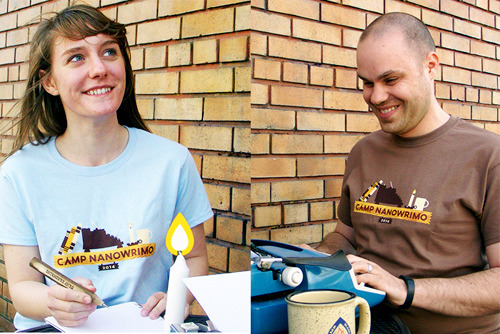Chris Baty's Blog, page 188
June 4, 2014
To A Future Writer: Writing Can Make You Bold
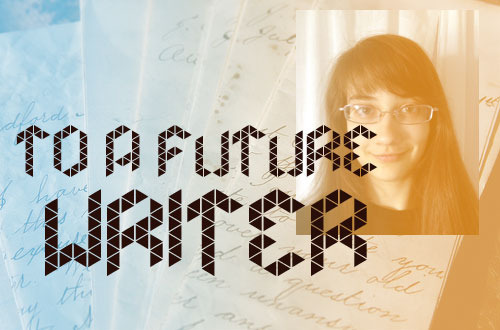
Inner editors are full of reasons not to write your story, echoing the voices out there that question if your story is worth telling at all. So why add to the chorus? We asked participants in our Young Writers Program to write a letter to their future selves about their hopes, dreams, and reminders of what they love about creating on the page. Today, 15-year-old Topaz reminds her future self of how writing made her less terrified:
Dear Future Topaz,
What comes to mind when you remember NaNo?
I guess I hope you remember the good things—the friends we made and the things we learned and the fun we had. Or maybe you remember the arguments and rage-quitting. If anything, I think you’ll remember the piles and piles of words we churned out.
Like, I don’t know if you still think this, but to be honest I’m pretty sure NaNo is the only reason I write, and am any good in social situations. (The two aren’t really connected, they just happened together.)
Who knows if I’d have kept writing if I hadn’t joined NaNo?
I doubt I’d ever have written thousands of words in a single month, and certainly not once or twice a year. Maybe short stories. I probably wouldn’t consider it a career option.
And when it comes to people… I’m sure you remember the first twelve years of our life when we were awkward and shy and generally terrified of interacting with people. I know it might seem a little weird to people who haven’t had this experience, but being able to explore myself online helped us start leaving the shell. (Now I’m just awkward. Does that last, I wonder?)
And ultimately, I guess it’s writing that led us to discover that. If I hadn’t been interested in writing, I’d never have found NaNo, and without NaNo I’d probably still be embarrassingly bad with people (and my terror toward the internet would have lasted a lot longer). Not to mention that thanks to NaNo there are people I can talk to all the time—and we even met some of them in person. That was so cool I can’t even. Wow.
Anyway, you’ll probably also remember being asked to write a letter to your future self and putting it off because writing letters is hard, let alone to yourself. But hey! If we hadn’t joined NaNo, we’d never have been asked to write this! …That’s not a reason why it would have been good to not join NaNo, by the way. NaNo’s great and I can’t imagine what we’d be like without it.
Writing is important. If you ever stop writing, I hope there’s someone around to get horribly disappointed in you. And maybe to stick your head in a bucket and tell you to start writing again.
Topaz, June 4, 2014
Want to write your own letter? Find out more about #ToAFutureWriter here!

Topaz is 15 and lives in California. She’s been a member of NaNo YWP since 2009, and has been an active part of the community since November 2010. In the years since she joined, she’s written over 470,000 words in event months alone, and it is absolutely ridiculous and who knows what she was thinking. (Though little of it has been worth exposing to the light of day.) At the moment, she’s revising the novel she wrote in November, and plans to self-publish by the end of June.
June 2, 2014
Q&A with Dominic Flask: On the Creative Process, and the Power of Limitations
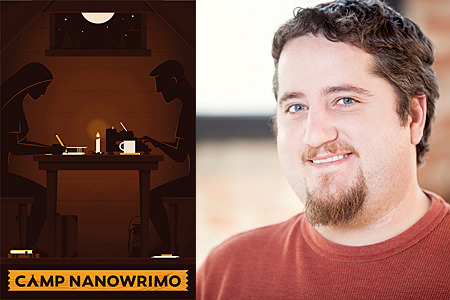
This year’s Camp NaNoWriMo design was created by Dominic Flask. You can see his “noveling by candlelight” design on this year’s poster, the 2014 T-shirt, and on the badges. After you do that, read about Dominic’s design process and how limitations can enhance his creativity:
When you begin a new creative project, how do you approach it? Are there routines that help ensure productivity?
Each project is always a little bit different in the nuances, but there are some big-picture steps that I try to follow.
First up is always research and development, questions for the client, a review of the customer base and competition, etc.
Second is the creative phase. This usually involves a shallow look at things first to gauge some initial responses. That might include sketches or a mood board type of exercise. The second step also includes the first dive on creativity as well, past the shallow look, but not too full-depth yet.
The third step is where we go all the way in and make sure we have all angles covered, that the application works everywhere it’s supposed too and that we figure out the production process to ensure everything is set up correctly.
If you can describe your artistic style in a sentence, what would you say?
Shapes and color are where it’s at, add a pinch of mid-century inspiration and I’m cooking up awesome.
What do you enjoy about mid-century modernism? How do you think it has inspired your work?
It’s a couple of things: the first being its reduction to only the necessities, whether that’s number of colors, materials, or otherwise. This was often a result of more restrictive production processes.
It’s also the personality. Mid-century modern design is fun and has a personal touch that the user experiences. I try to add that little bit of personal fun into all of my work.
It’s also just the style; the mid-century had class and a timelessness that you just can’t argue with.
If you could shadow any designer (past or present), who would it be?
Tough one, so many. I’ve been lucky enough to have some close encounters with two of my favorite current designers: Ben Schlitter and Luke Bott. There are too many other current and previous designers to name though that I would love to spend just one day with them all. Just hanging out and working.
You are on a camping trip. The sun has set. Everybody is huddled around the campfire and it is your turn to tell a story. What story would you tell?
There’s no way I can explain this one in writing, but let’s just say that the most memorable event in my life involved a rhinoceros, a possible UFO sighting, a ‘64 Chevelle, and a whole lot of adrenaline.
Dominic Flask is an independent designer and illustrator, with a passion for graphic design, education, and all things mid-century. His career has provided unique and interesting opportunities to work with everyone from small local businesses to international corporations. His talents apply to a wide variety of different design media including interactive, mobile, print, identity and motion. His mission is to make the world a more beautiful place to live in, one small piece at a time.
May 30, 2014
Camp NaNoWriMo Is Opening Its Doors Again!

Camp NaNoWriMo has relaunched for the July session! Now, if you’ve never joined us for Camp before, you might wonder: What makes Camp special?
You can write whatever you want here. Many of us do novels, sure, but each session there are folks working on everything from screenplays to memoirs. When you create your project, consider exploring a new genre; that’s what Camp is for!
You’ve got a ready-made community. Cabins will match you with equally enthusiastic writers, and can start some amazing conversations among people from across the globe. You’re welcome to set your cabin preferences now, but you may want to wait and see what we have up our sleeves…
You’re part of a huge NaNoWriMo community, too. If your cabin’s a little quiet or not to your liking, join us on Facebook, Twitter, or the NaNoWriMo forums. Find a way of reading and interacting that works best for you.
We’ve got lots of assistance for you. During June and July, we post Camp-specific advice almost every day right here on the blog. You’ll also find a pep talk in your Camper Messages every Thursday. And, our Writing Resources page contains our full archive of articles and pep since Camp’s founding in 2011.
This idyllic writer’s retreat keeps getting bigger, and we’re so excited to share it with you.
Counting the days until July 1,
Chris Angotti
Director of Programs
May 28, 2014
Stories of Tomorrow: How the Joy of Writing Spreads...
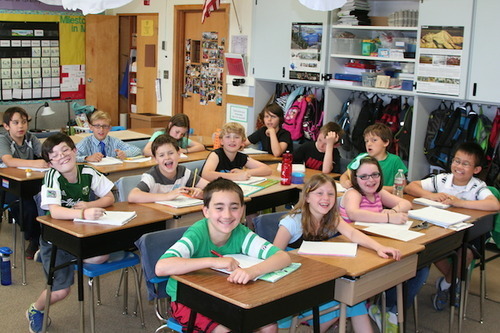
Tomorrow’s stories start in all sorts of places: on the drive to work, or at the movie theater. One constant source of inspiration? The classrooms that tackle NaNoWriMo through our Young Writers Program. YWP educator Connie Greenlee tells us about watching the joy of writing become infectious:
My husband first participated in NaNoWriMo nine or ten years ago and noticed the Young Writers Program on the website. He encouraged me to use NaNoWriMo with my 4th grade students. The first year was really an experiment, and so successful that I’ve been doing it every year since.
At first, some said that NaNoWriMo doesn’t fit the curriculum and were hesitant about the value of it. But these doubts and hesitations went away when they saw how engaged and excited the kids are about writing and how that engagement continues on year after year. Allowing the students to choose what they write about is very empowering for them. There are often results that I don’t expect.
One of the really surprising results is how often the students want to write. They work on their novels at home in the evening and on the weekend, they write at recess, they ask to write any time they have a free moment. They talk about their writing when they are walking down the hall, at lunch, and on the playground. They discuss with each other characters and setting and what will happen next. When another student is stuck, they willingly make suggestions to help them get un-stuck.
A couple of times during November, I invite students to join me on Friday nights at a local restaurant. We write and talk about writing for a couple of hours. Even past students will ask to join us. One restaurant patron called us an “elite writing group.” (That was fun to overhear!) I love that nine and ten year olds will get their parents to take them to write on a Friday night.
Also, kids no longer say they can’t write, don’t want to write, or struggle to complete a writing assignment. They have confidence in themselves and know they can accomplish anything. Their confidence and stamina for writing carries on to future years.

One of my favorite memories was when one of my boys came to me at the end of our NaNo time and said, “Mrs. Greenlee, I’m 5 words away from 5,000!” He was so excited. I told him to go write those 5 words. A couple of years ago, I had a blended class that included students from different grades. At least two of those students during their second year of NaNoWriMo wrote over 20,000 words—pretty amazing for fourth graders.
Younger students in our school know about NaNoWriMo. When they come into my classroom on the first day of school, they will ask if we are going to do NaNoWriMo that year. They can’t wait! It changes every student’s attitude about writing, from something they might resist or dread, to something they look forward to and enjoy.
NaNoWriMo has spread from just one classroom in our school to all the intermediate classrooms. As the program continues, I would like to see parents dropping in to write with their children, the entire school—teachers, students, and every person working in our school—writing together in the gym.

Connie Greenlee teaches at West Union Elementary School in Hillsboro, Oregon. She has taught NaNoWriMo for 8 or 9 years and personally participated in NaNo each year with her students, finishing 50,000 words twice.
May 23, 2014
I Published My NaNo Novel: Kate Danley on Writing Habits that Can Pay Your Rent
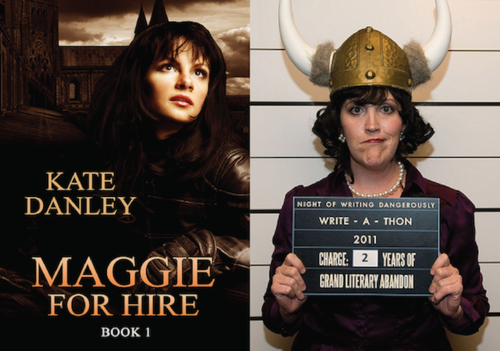
Kate Danley is a NaNoWriMo veteran from Los Angeles, CA, who has sold 130,000 copies of her first NaNo-novel, Maggie for Hire. She’s also a veteran of the stage and screen. We talked about her writing process as a best-selling author and how her experience on stage influenced her writing:
Five of your bestsellers are NaNoWriMo novels. What was your experience like when you participated in NaNo and what do you find helpful about participating?
I self-published my very first book, The Woodcutter. It took me a year to write and I went through five years of rejection letters, and afterwards, I was faced with the great “What Next?”
Was I going to be a one-hit wonder or was there another book lurking inside my soul? That’s when I discovered NaNo.
It seemed a great way to get started on my next project. I could dive into the deep end and just start swimming. At the time, I was still balancing a full-time job and full-time acting career, so NaNo was wonderful for getting focused. I have met so many talented authors over the years, authors I believe are much more talented than me, but they get distracted and forget to write. All of their wonderful, gorgeous words just sit there dying on their hard drive.
The biggest gift of NaNo was teaching me how to write just a little every day, how to meet goals, and how to make it fun. There is joy in gathering up other writers in a cool coffee shop and hacking out some words. It is a riot turning writing into a group event. I attended The Night of Writing Dangerously twice and wrote some of my best stuff!
As I made the transition into being a full-time writer, the habits I developed in NaNo became the tools which keep my rent paid: write every day, set goals, and get yourself a supportive posse. Every day is NaNo now!
You have a lot of experience performing on stage. What is your approach when writing a story versus performing one? How has your theater background influenced the stories you write?
Four of my NaNo books are in my snarky urban fantasy Maggie MacKay: Magical Tracker series. When I started writing them, I was doing a lot of sketch and standup. There is nothing like bombing in front of an audience to make you better at writing a joke. But more than just writing jokes, I figured out that the strongest stories, either performed or written, are the ones with rich characters. You are shooting yourself in the foot if you go onto stage to “be funny.” But you will be funny if you step onto the stage as an honest character with a specific world view which is just… a bit… off.
In the writing world, it is impossible to write anything good if you’re sitting at the keyboard with the objective of “writing the Great American novel.” But you can write the Great American novel if you have a three-dimensional character with a story that must be told.
When I prepare a character for stage, it is important to know what drives them. What do they want in a scene? What are their hopes? Their dreams? Their favorite color? How do they style their hair? What kind of shoes to the wear? It is in analyzing how their brain works that you can step into their skin and bring them to life.
As time has passed and I have written more series books, defining a character in the early stages becomes more and more important. Write these character traits down! There is no hell like trying to remember the favorite sandwich of a character you introduced in book one while you’re writing book five! If I need to write a book a year after I have last visited these characters, defining them gets me back in the game faster.
Has your writing process changed after winning awards and reaching bestseller status?
There is a certain level of pressure that comes once you start seeing some success. You feel a responsibility to create something which will delight the people who have supported you. Sometimes that can be overwhelming.
I think Neil Gaiman said it best: never do anything your heart isn’t in. I made the mistake of working on projects for the “opportunities.” The opportunities all imploded and I was left with projects that didn’t make my heart sing. You are a unique soul and the stories in your brain cannot be told by anyone else in the world. Honor that! Collaborations are fine, but make sure to place your art, your world, your gift first.
What is your advice for writers who are struggling with revising their work?
Sadly, much like housework before a party, it is just something you have to buckle down and do before you can have fun. I work with the timer method (I credit The Fly Lady with introducing me to this). The premise is that you can do anything for fifteen minutes. So, sit down, set the timer for fifteen minutes, and get cracking.
I find that once I get started, it is easy to keep going! But if for some reason I’m having one of “those days”, once I do my fifteen minutes, I can get up guilt-free and enjoy the rest of my day. Editing is like eating a whale: do it one bite at a time.
What is your favorite play? How has your acting experience influenced your screenwriting/playwriting?
Once every five to ten years, I will have the privilege of doing a show which is divine. It is the perfect balance of an incredible script, incredible cast, wonderful role, and a darling production team that you just want to hug 24/7. The last I did was called Blake… da Musical! It was written by the wickedly smart Rick Batella with music by comedian Henry Phillips. They would do anything for a laugh.
I played a meth-head, trailer park, fairy godmother who was followed around by two mullet-wearing mechanics and a bubble machine. It sounds kind of goofy, but what made that show so special was that it was filled with such gentle affection. Every performance was a joy. It was like a summer camp which lasted for a year. It was my Firefly. The play went on to win the Ovation, which is Los Angeles’ version of the Tony, and rightfully so. It has been eight years since that show closed, and my heart is still broken that it didn’t get to go on forever.
What that experience taught me was the importance of love in art. Writing and acting, in their highest forms, should feel like flying, should feel better than anything else in the world. There are times I get away from that, times I get blocked, but it is love which ultimately will bring you back. Whether you are writing for the page or the stage, search out the things that delight you. Chances are, there are some other folks it will delight, too.
USA Today Bestselling author Kate Danley began her writing career with the novel The Woodcutter (47North). It was honored with the Garcia Award for the Best Fiction Book of the Year. Over 250,000 copies of her books have been sold internationally. Her plays have been produced in New York, Los Angeles, and DC Metro area. She trained in on-camera puppetry with Mr. Snuffleupagus and played the head of a 20-foot dinosaur on an NBC pilot. She lost on Hollywood Squares.
May 21, 2014
Campfire Stories: In Which Fellow Writers Trigger New Visions
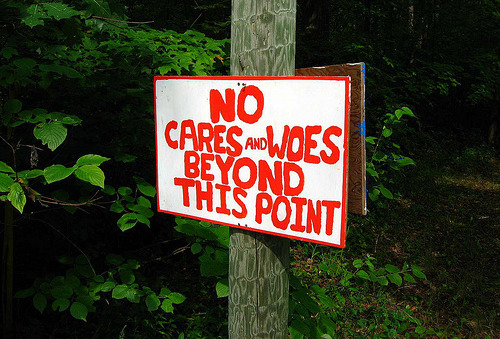
Our Municipal Liaisons volunteer every November to run in-person write-ins, encourage the writers in their local regions, and generally be conductors of creative energy. This past April, several of them joined in on Camp NaNoWriMo to bring their special brand of imagination fuel. Today, Sini Veneskoski, ML in Finland, shares what she learned from her fellow writers:
Here are a few things I learned from my 10 cabin mates this past Camp NaNoWriMo:
A pillow fight may turn into a shovel-tossing frenzy, when a bunch of happy campers share a 12-story bunk bed for 30 days.
Tar can be hazardous to your story.
Wet owls may occasionally need to warm up in the sauna, but you should light the sauna oven, not the sauna itself.
Cauliflowers can be dangerous and addictive.
And cabin fever can induce extreme productivity, although every now and then it may be wise to lock yourself in the potato cellar, in order to reach your par for the day.
This April’s Camp NaNoWriMo wasn’t my first camping experience, but it was by far my most intense one. And while some of the lessons I learned in our cabin may sound like utter nonsense, they added up to something far more substantial: While spending a month immersed in such musings, the 11 of us successfully tackled a joint word count of more than half a million, with every one of us reaching our personal goals.
My own challenge was the umpteenth and hopefully final round of revision of my 2012 NaNo-novel, a 90,000-word police thriller, which has haunted me since it first saw the light of day. I’m very grateful to my cabin mates for throwing me repeatedly back into the potato hole. After all, they did it only to help me with my novel, right?
Well, help they did, and not only with that unique way of butt-kicking. Some of my more computer savvy cabin mates kindly served as a reference desk for me, when I needed to get some crucial technical details in order in my story.
When I felt the urge to shout out stylish palindromic word counts, needed a second opinion on plot twists from my trusted and brave beta reader, or was searching for new ideas, I snuck out of the cabin and headed to our home forum to say hi to other Finnish campers, who tended to hang out there as well as in cabins, more often than not. After these visits I returned to my hole and to my story, bringing with me names for new characters, new forms of tormenting my poor tough-luck guy, an enormous stuffed pike, and a most solemn dream sequence featuring corpses, King Arthur and coconuts.
Once again, it was all about interacting with people: about company and conversation, ideas and inspiration, advice and a shared agenda. While writing is what happens between you and your characters, getting it done benefits immensely from outside influences. It’s true for old and new projects alike, at least for me: Input from others can trigger new visions, unstick the stuck, set facts straight and simply make it so much more fun.

Sini Veneskoski has been an active Wrimo since 2007 when she joined, ML for Europe: Finland since 2013, and has written seven November NaNo-novels, attempted Script Frenzy twice, and participated in three Camp NaNoWriMo sessions.
Top photo by Flickr user Peter Blanchard.
May 19, 2014
"At this point in a story, voices in our heads whisper that we’re wasting time. Why are we..."
Don’t listen. Storytelling is a powerful act. Stories have the mysterious power to widen hearts and change minds. The human psyche is never quite the same after receiving a story.”
- Mitali Perkins, on the secret power of novelists.
May 16, 2014
Campfire Stories: In Which Feedback and a Writing Community Make All the Difference
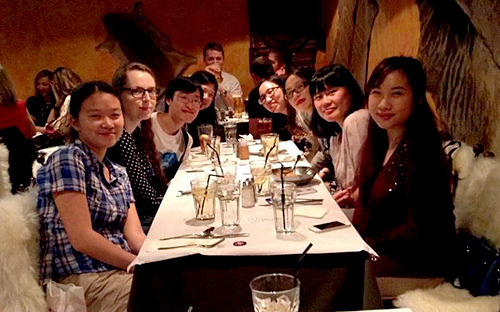
Our Municipal Liaisons volunteer every November to run in-person write-ins, encourage the writers in their local regions, and generally be conductors of creative energy. This past April, several of them joined in on Camp NaNoWriMo to bring their special brand of imagination fuel. Today, Amanda Tong, ML in Hong Kong, shares how just one writerly friend can make all the difference:
Here’s a confession: part of why I volunteered to be a NaNoWriMo ML was to get to know some writers. I’d come home to Hong Kong after four years of undergrad. The only people I knew there were secondary school friends, a number that I could count on my fingers. Since I had just rediscovered the joys of writing—weaving my own stories, witty wordplay, and the amazing thought ‘Hey, I might be onto something good’—I wanted to find others who felt that way. I wanted to find writers. And making sure that there would actually be write-ins for me to attend was one way to do it!
It was a delight to meet these students, teachers, travelers, etc. especially when they dropped those titles to unite as writers. We were a tiny but happy little group, all chugging towards that 50,000 in between the coffee consumption and serious debates over what was the scariest monster from Doctor Who. Important writer stuff.
But by January, it seemed like most people had put their writer selves into hibernation until further notice, maybe next November, even. One Wrimo already had an established writing group where I did see some writers surface for air every few weeks, but not always. I knew I couldn’t force anything (Hong Kong is a city of involuntary workaholics) so I tried not to get too excited when I made a post about Camp NaNoWriMo on our Facebook group in early March.
Just one post and the writers came creeping back. What’s more, they came back and took things into their own hands. Somebody remarked that the weekly writing session was at a rather inconvenient time for them, so would anyone like to join them on Sunday mornings? Another Wrimo agreed, saying the location was far, too, so what about this nifty café on Thursdays? In that case, added a third, could we consider rotating venues?
Suddenly, I had three opportunities a week to see my lovely writer friends again. I still hosted an “official” write-in of my own featuring origami “plot bunnies” as an Easterly nod, but NaNoHK’s April 2014 Camp was essentially borne on the shoulders of its awesome Wrimos. They challenged each other with word sprints, celebrated when someone hit their daily word count, and brainstormed character/item names together. We broke free from the crazy pace of Hong Kong to be one entity again, sort of like a hive mind of wonderful writerness. Maybe like the Ood. (Love an Ood.)
Then when their bold and fearless ML faced her own story hurdles, they gave her wise and practical advice for moving the story along, focusing on the characters.
I’ve always been a people person, so feedback is a central element in getting through a new piece. A simple conversation about the concept might be all that takes for motivation to kick in again. It’s enough to see somebody else genuinely interested in what you have to say, that they’re thinking, ‘Hey, you might be onto something good.’

Amanda Tong currently works as a kindergarten music teacher as she completes her MFA in Creative Writing at HKU. November 2013 was her first year as a NaNoWriMo ML, part of a plot to make new literary-minded friends in the city where she grew up. It worked magnificently. One day, she would like to be the proud author of published novels, short stories, plays, and possibly even a graphic novel. She would also like to own a Roomba painted to look like the Millennium Falcon.
May 14, 2014
Campfire Stories: In Which There Are Lurkers In the Woods and Tips on Tackling New Genres

Our Municipal Liaisons volunteer every November to run in-person write-ins, encourage the writers in their local regions, and generally be conductors of creative energy. This past April, several of them joined in on Camp NaNoWriMo to bring their special brand of imagination fuel. Today, Lisa Raney, one of the MLs for Hawaii, shares how she tackled a brand new genre:
I headed off to Camp NaNoWriMo with my backpack full of good intentions, my novel rolled up in my sleeping bag, and ready to meet my fellow campers. Unlike my NaNo experiences with in-person write-ins, my Camp experience was vastly different. My cabin mates were scattered around the country so interactions were solely through our cabin messages.
My first day at Camp gave me déjà vu, reminding me of childhood experiences of going off to camp, the shy girl suddenly faced with a group of strangers with a common goal. Not to worry. My fellow cabin mates were welcoming and equally excited to tackle their Camp NaNo goals. Each day, I looked forward to checking in at my cabin and seeing what messages awaited me and my fellow campers, and to give feedback and support as the month wore on.
Most of my cabin mates were working on new projects with ambitious word-count goals. I was determined to use my time at Camp to do some major editing of my November novel, then hammer out the ending to the story, which had been stuck in limbo since the conclusion of NaNoWriMo.
In editing alone I gained 10,000 words, yet when it came time to start adding new material my effort began to lag. I turned to my cabin mates for inspiration but found a sudden lack of activity on our message board. For a moment I thought perhaps I was the last camper left as others were quietly picked off by the scary lurker in the woods. I posted a message of encouragement. The crickets chirped ominously in reply. Then, in the final hours, there was life. I wasn’t alone at Camp, and I wasn’t the only one falling short of my goal.
As April rolled over into May, and I carried my s’more-sticky, campfire-scented backpack home, I realized that, despite not hitting my word count goal, I was buoyed by all that I’d accomplished.
Perhaps my stumbling block has to do with this being my first attempt at a new genre. It seemed quite daunting when I sat down to type out the first words. I knew how I wanted my story to play out—the tempo, the feel—but had no idea how to successfully pull it off.
I found that when tackling a new project or genre as a writer, you can pull from your experience as a reader. What are the elements your favorite authors use to bring that style to life? I would think of stories where my genre was successful, then try to apply those same key components to my own writing. It seems to be working thus far. In fact I am now looking forward to taking up my tale once more, and this time following it to its conclusion. Perhaps I will head off to Camp again this June.

Lisa is a 41-year-old wife, mother, and grandmother who has a generally upbeat view of life and the world around me. She started participating in NaNoWriMo with the encouragement of her teenage daughter who had successfully won three NaNo’s in a row. She is now one of the MLs for the state of Hawaii.
Top photo by Flickr user tslaks82.
May 12, 2014
Publish Your Book in 6 Weeks: a BookBaby Guide

As a NaNoWriMo sponsor, BookBaby is providing a comprehensive, 6-week guide to turning your first draft into a published book that “will catch readers’ attention, get reviewers talking, and take you to the next level in your writing career.” Download the full guide now, or get a preview of it below:
You worked hard writing your novel; it would make sense that you’d want your words to find an audience. What you do from here on out will determine whether or not someone reads the words in your manuscript. That’s why it’s important to find the right balance between strategically planning your launch (so you’ll be able to build interest in your book), and getting things done according to a timeline—because the last thing you want to do is sit on a finished manuscript indefinitely.
So: what goes into planning your book’s launch into the great big world out there?
(Note: You’ll most likely be working on several of the steps mentioned below concurrently. For simplicity’s sake, let’s assume you’re allotting 2-4 weeks for each step with overlap. At that rate, you’ll be able to successfully launch your book in 6-12 weeks. )
Step 1: Know when you’re really done with your book
First, try re-reading your manuscript with fresh eyes. Pretend it’s a brand new book written by someone else. If you find any flaws, fix ‘em; but chances are you’re too close to your own writing to be able to make objective decisions at this point. That’s why you need to find some careful and qualified readers to help you polish up your manuscript before publication.
Bring your manuscript to your writing group and circulate it among trusted writers, teachers, mentors, or other professionals in your community. If you don’t have an extensive local writing community, get help from online writing and critique groups on the NaNoWriMo forums, or sites such as Skypen, World Literary Cafe, You Write On, or Authonomy.
Step 2: Edit your book (It’s essential.)
Even the most successful authors in the world work with professional editors, and you should too. Unfortunately, editing is the publication steps indie authors most often skip, and it shows in their work. No matter how good your manuscript, an editor can help you make it great.
Whether you need to work with a developmental editor on a major revision, a copy editor to make your prose sparkle, or a professional proofreader, editing is essential to publishing a successful book.
To see how a professional editor can help you improve your book, get a sample of your writing edited for free by FirstEditing.com.
Step 3: Prepare your book for publication
Before you print your books and/or publish an e-book, you’ll want to come up with some jacket copy and a captivating book blurb that will help you sell your book. You should also consider printing galleys and sending them out to services such as Kirkus Indie for early review. That way you’ll have some quotes from professional book reviewers to include on the back of your book, in your press materials, on your website, and more.
When it’s time to move ahead with publishing, make sure your book has a great cover, is formatted properly for e-book conversion, and that your printed book has an attractive and reader-friendly design.
Step 4: Get a jump start on book marketing basics
The last thing you want to do is publish a book and then start thinking about how to market it. You need to begin your book marketing preparations well in advance of your launch.
If you don’t have a website, get one! Then put together your basic book promotion materials, including:
an author bio
an author photo
web content that boosts your online presence
hi-res image of your book cover
a press release
book trailer
and more
You should also look into running a Goodreads giveaway in advance of your book release to build anticipation and increase your chances for additional reader-generated reviews.
Step 5: Publish your book
The time has arrived. You’ve prepared, and now you’re ready to:
print your book and distribute the first 100 copies before your launch date.
publish your e-book for iBooks, Kobo, Kindle, Nook, and many more.
Step 6: Promote your book
Once your physical books are printed and your digital books are available on all the popular eBook retail stores, it’s time to get the promotion machine going full-steam-ahead:
promote your book on an indie budget with these 20 thrifty ways to get your book out there.
promote your book with social media, and be sure to follow these ten social media rules for authors.
plan your own virtual book tour, including stops at various book blogs, publishing industry websites, podcasts, radio shows, and more.
plan an actual book tour.
seek out more reviews for your book from bloggers, book critics, and more.
explore a few of these book launch strategies.
If you’ve completed everything up to this point, nice going! It’s time to pat yourself on the back; you’ve taken your book all the way from the first word on the first page through publication and promotion. The only thing left to do is host an unforgettable book launch party to celebrate your achievements with your supporters.
Have a blast. You earned it.
Christopher Robley is the 2013 winner of Boulevard’s Poetry Prize for Emerging Writers. His writing has been published in Prairie Schooner, Poetry Magazine, RHINO, Magma, and more. Robley’s music has been praised by the likes of NPR, the Los Angeles Times, and the Boston Globe. Skyscraper Magazine called him, “one of the best short story musicians to come along in quite some time.” He is also the editor for the BookBaby Blog and CD Baby’s DIY Musician Blog.
“The End.” Now what?
From manuscript to published book
As a NaNoWriMo novelist, you may’ve written 50,000 captivating words — but you don’t have a finished book yet. You’ve still got to think about editing, design, printing, eBook distribution, promotion, and more.
I assume you worked hard writing your novel; obviously you want your words to find an audience. What you do from here on out will determine whether or not anybody actually reads those words in your manuscript. That’s why it’s important to find the right balance between strategically planning your launch (so you’ll be able to build interest in your book), and getting things done according to a definite timeline — because the last thing you want to do is sit on a finished manuscript for another year or two.
If you’re willing to put energy into the publishing and promotion process, it’s possible to establish an author brand, build your readership, and boost your chances of self-publishing success in a matter of months. This article provides one possible path towards that goal.
Note: You’ll most likely be working on several of the steps mentioned below concurrently. For simplicity’s sake, let’s assume you’re allotting 2-4 weeks for each step with overlap. At that rate, you’ll be able to successfully launch your book in 6-12 weeks.
Step 1:
KNOWING WHEN YOU’RE REALLY FINISHED WITH YOUR BOOK
First, try re-reading your manuscript with fresh eyes. Pretend it’s a brand new book written by someone else. If you find any flaws, fix ‘em, of course; but chances are you’re too close to your own writing to be able to make objective decisions at this point (as if you could ever make objective decisions about your own work!). That’s why you need to find some careful and qualified readers (NOT your friends and family) to help you polish up your manuscript before publication.
Bring your manuscript to your writing group and circulate it among trusted writers, teachers, mentors, or other professionals in your community. If you don’t have an extensive local writing community, get help from online writing and critique groups such as www.skypen.com, www.worldliterarycafe.com, www.youwriteon.com, or www.authonomy.com.
Step 2:
EDITING YOUR BOOK, AND WHY IT’S ESSENTIAL
Even the most successful authors in the world work with professional editors, and you should too. Unfortunately, editing is the publication step indie authors most often skip, and it shows in their work.
No matter how good your manuscript, an editor can help you make it great.
Whether you need to work with a developmental editor on a major revision, a copy editor to make your prose sparkle, or a professional proofreader, editing is essential to publishing a successful book.
To see how a professional editor can help you improve your book, get a sample of your writing edited FOR FREE by FirstEditing.com .
Step 3:
PREPARE YOUR BOOK FOR PUBLICATION
Before you print your books and/or publish an eBook, you’ll want to come up with some jacket copy and a captivating book blurb that will help you sell your book. You should also consider printing galleys and sending them out to services such as Kirkus Indie for early review. That way you’ll have some quotes from professional book reviewers to include on the back of your book, in your press materials, on your website, and more.
When it’s time to move ahead with publishing, make sure your book has a great cover, is formatted properly for eBook conversion, and that your printed book has an attractive and reader-friendly design.
Step 4:
GETTING A JUMP START ON BOOK MARKETING BASICS
The last thing you want to do is publish a book and THEN start thinking about how to market it. You need to begin your book marketing preparations well in advance of your launch.
If you don’t have a website, get one! Then put together your basic book promotion materials, including:
an author bio
an author photo
web content that boosts your online presence
hi-res jpg of your book cover
a press release
book trailer
and more
You should also look into running a Goodreads giveaway in advance of your book release to build anticipation and increase your chances for additional reader-generated reviews.
Step 5:
PUBLISH YOUR BOOK
The time has arrived. You’ve prepared, and now you’re ready to:
print your book and distribute the first 100 copies before your launch date.
publish your eBook for iBooks, Kobo, Kindle, Nook, and many more.
Step 6:
PROMOTE YOUR BOOK
Once your physical books are printed and your digital books are available on all the popular eBook retail stores, it’s time to get the promotion machine going full-steam-ahead:
promote your book on an indie budget with these 20 thrifty ways to get your book out there.
promote your book with Social Media (especially on Twitter), and be sure to follow these10 social media rules for authors.
plan your own virtual book tour, including stops at various book blogs, publishing industry websites, podcasts, radio shows, and more.
seek out more reviews for your book from bloggers, book critics, and more.
explore a few of these free (or mostly free) book launch strategies.
———
If you’ve completed everything up to this point, damn! Nice going. It’s FINALLY time to pat yourself on the back; you’ve taken your book all the way from the first word on the first page through publication and promotion. The only thing left to do is host an unforgettable book launch party to celebrate your achievements with your supporters, fans, and the media.
Have a blast. You earned it.
———-
This article provides just the tip of the iceberg in terms of self-publication strategies. If you’re looking for more details about successfully publishing your novel, download our FREE guide: “6 Steps to Take Your Manuscript to Marketplace in 6 Weeks.”
Author Bio: Christopher Robley is the 2013 winner of Boulevard’s Poetry Prize for Emerging Writers. His writing has been published or is forthcoming in Prairie Schooner, Poetry Magazine, Poetry Northwest, RHINO, Magma, Beloit Poetry Journal, and more. Robley’s music has been praised by the likes of NPR, the LA Times, and the Boston Globe. Skyscraper Magazine called him, “one of the best short story musicians to come along in quite some time.” He is also the editor for the BookBaby Blog and CD Baby’s DIY Musician Blog.
Chris Baty's Blog
- Chris Baty's profile
- 63 followers


